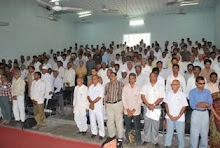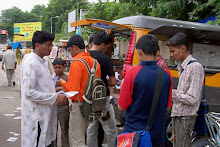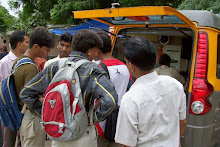Calcutta
Telegraph: New Delhi: Friday, 17 July 2015.
For 10
months, the Narendra Modi administration withheld from the public the findings
of a study by India's government and Unicef that charts
"unprecedented" improvement in child malnutrition over the past
decade but shows Gujarat in an unflattering light.
Under
pressure after The Economist reported the findings a fortnight ago, the
government last week released the national-level data from the Rapid Survey on
Children. But it is still withholding the state-wise figures, questioning their
accuracy.
Unicef has
not expressed any concern about the data's correctness, though, and media
speculation has it that the figures have been held back because they show the
state Prime Minister Modi ruled for 13 years as lagging many poorer ones.
Government
sources said the UPA government had commissioned the survey in November 2013
and the final report reached the Modi government in September last year.
But Dipa
Sinha, a right to food campaigner, told The Telegraph an RTI query she had
moved six months ago received a response only on June 30, saying the government
had just a provisional report. The Congress today released the full findings,
including the state-wise data.
According to
the study, the national percentage of underweight children below the age of
five has fallen from 42.5 a decade ago to about 29 - gains that Unicef's
nutrition adviser for South Asia, Victor Aguayo, has been quoted as terming
"unprecedented".
In Gujarat,
the figure has dropped from 44.6 to 33.5 per cent, which is worse than the
national average. "While UPA was winning the battle against malnutrition,
Gujarat was losing it," the Congress crowed.
In absolute
terms, India is far behind Africa, where 21 per cent children are underweight.
Gujarat also
lagged the national average at 42 per cent for "stunting" (when
children are unusually short for their age), 18.5 per cent for severe stunting,
and 18.7 per cent for "wasting" (when children weigh too little for
their height).
While the
immunisation coverage in the country rose from 61 per cent in 2009 to 65.2 per
cent, that in Gujarat fell from 56.6 to 56.2 per cent.
Modi had in
an interview to The Wall Street Journal in 2012 attributed Gujarat's poor
malnutrition figures to its largely vegetarian population and a middle class
"more beauty-conscious than health-conscious".
"If a
mother tells her daughter to have milk, they will have a fight. She will tell
her mother, 'I won't drink milk, I'll get fat'. They have money but she's
beauty-conscious, not health-conscious," the then Gujarat chief minister
had claimed.
An official
in Maneka Gandhi's women and child development ministry, which has uploaded the
survey's national figures on its website, denied that the state-wise data had
been held back because of Gujarat's figures.
"We
never accepted the survey results as they contradict other surveys," he
added, saying many states had objected to the findings and the health and
statistics ministries questioned the survey's methodology.
Apparently, no
such doubts assailed the survey's national figures. The ministry set up a panel
to review the state-wise data only last month - no one was available to explain
the delay. Maneka, away in Chhattisgarh, did not reply to text messages.
Media reports
said the Rapid Survey was based on 2.1 lakh interviews across 29 states and
Union territories in 2013 and 2014, and measured and weighed over 90,000
children and 28,000 teenage girls.
The
"other surveys" that the official said it contradicts are the
district-level health surveys done in 2013-14 across 21 states (but not
Gujarat). Nutrition and food campaigner Vandana Prasad said these surveys
differed with the Rapid Survey in some of the data but did not paint "a
better or worse" picture overall.
The decade-old
data the Rapid Survey has contrasted with its findings to determine the gains
are from the Centre's National Family Health Survey of 2005-2006. The latest
NFHS is now under way.
Prasad said
the worst aspect of the withholding of the data was that it left everyone in
the dark about the progress in fighting malnutrition.
"It's
ridiculous that people working in the field have to beg for data from the
government," she said. "Also, had they been made public, the budget
cuts might not have happened."
The allocation
for the Integrated Child Development Services was slashed from over Rs 18,000
crore in last July's budget to about Rs 8,000 crore in this year's Union
budget, and that for the midday meal scheme from Rs 3,000 crore to Rs 1,200
crore.
The Rapid Survey
lauds the performance of Maharashtra (at a time it was under a Congress-NCP
government) as exemplary. It attributes the state's success to better feeding
of infants, pregnancy care, higher incomes and motherhood at more mature ages
as well as its outreach to the poorest, like the Adivasis.
It also
paints BJP-ruled Madhya Pradesh and Nitish Kumar's Bihar as front-runners in
improvement (though not in absolute figures).
The
percentage of undernourished children dropped from 60 to 36 per cent in Madhya
Pradesh, from 56 to 37 per cent in Bihar, and from 37 to 25 per cent in
Maharashtra.
Nationally,
the percentage of wasted children fell from 20 to 15 per cent, and that of stunted
children from 48 to about 39 per cent. However, the survey found more than half
of Uttar Pradesh's children below normal height.
It found more
than a quarter of children stunted even among the wealthiest 20 per cent of
Indian households, a probable fallout of rampant sexism. Over half of girls
aged 15 to 18 were underweight, and therefore likelier to give birth to
malnourished babies, media reports said.
The survey
found failed deworming campaigns and poor breastfeeding practices. It blamed
open defecation - whose practitioners have dropped from 55 per cent of the
population a decade ago to 45 per cent - as a key cause for the spread of
diseases that contribute to malnutrition.
"Holding
the (state-wise) data back is leading to unnecessary speculation," said
Biraj Patnaik, nutrition expert and Supreme Court-appointed principal adviser
to the food commissioner. "As a nation, we have done well overall and
though there may be inter-state variations, the government should make the data
public."














































































